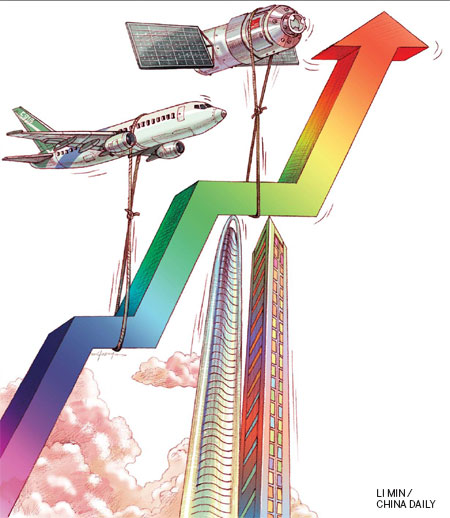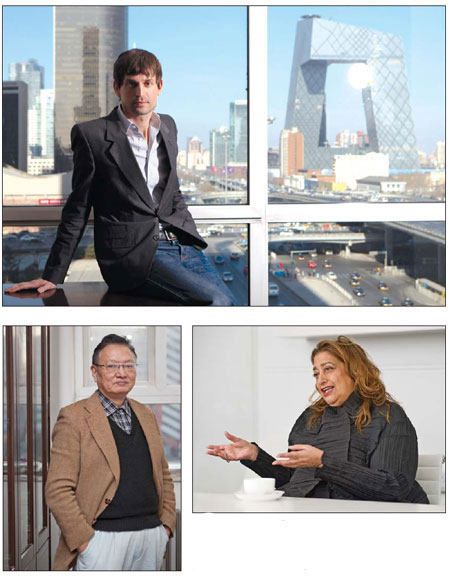Lasting legacy
Updated: 2011-12-30 08:51
By Andrew Moody (China Daily)
|
|||||||||

Big ticket, new-age projects to help China establish a permanent footprint on global center stage
Do countries need large-scale projects to announce their arrival on the world stage as a major economic force?
China is currently investing billions on major infrastructure development, groundbreaking architectural projects and in science and technology in such futuristic fields as space exploration, supercomputers and robotics.
The world's second-largest economy is not the first to make such bold statements.
Even the Greeks when building the Parthenon in the 5th century BC wanted to create something that would be a lasting legacy of their society.
| ||||
The Americans announced their emerging economic power by the construction of vast skyscrapers such as the 102-story Empire State Building, which after being completed in 1931 was the world's tallest building for 40 years.
Their achievements did not just stop there. The pinnacle was arguably the most impressive scientific achievement of all time, the landing of a man on the moon in July 1969.
Some argue that China's recent investment in major projects has been excessive and has led to heavy local government debt.
China's National Audit Office reported in June that local government debt had reached $1.7 trillion (1.3 trillion euros), some 27 percent of the country's gross domestic product.
But one of the major questions is whether big projects are just a country showing off its new status in the world or an inevitable by-product and consequence of just being a strong economic force in the world.
Martin Jacques, the British academic and journalist and author of When China Rules the World, which argues that China would become the dominant power in the 21st century, believes all emerging societies like to put themselves on the map with big projects.
"I think most seriously rising societies have at some point had big projects. I think it goes with the territory and is not just reducible to some prestige or reputational purpose."
In this issue, we look at 10 of China's great projects of the early 21st century and assess their value and whether they are symbols of the former Middle Kingdom's new world status.
These include the world's longest sea bridge, spanning some 36 kilometers across the mouth of the Jiaozhou Bay in eastern Shandong province and which would easily cross the English Channel, and also the 606-meter skyscraper in Wuhan, the capital of Hubei province, which when completed will be the third-tallest building in the world.
We also feature the over-1,000 km 350 km/h high-speed railway from Wuhan to Guangzhou, which reduced the traveling time between the two cities from 11 to just three hours.
It will eventually form part of a 2,100 km link between Beijing and the capital of Guangdong province.
Another major project is the 1,800 seating capacity Guangzhou Opera House designed by the British architect Zaha Hadid at a cost of 1.38 billion yuan ($218 million, 168 million euros).
We also highlight developments in China subway systems, focusing on Wuhan, where the first line has been built but others - which will be among the most advanced in the world - are currently under construction.
China is also setting up in competition against Airbus and Boeing with its C919 airliner being built by the Commercial Aircraft Corporation of China and which is set to take to the skies in 2014.
The country also wants to make its mark in space and plans to have its first manned space station orbiting the earth by 2020.
It is not just the heights of space but the depths of the ocean that China wants to explore.
The Jiaolong, which is named after the mythical Chinese sea dragon, is expected to dive to 7,000 meters beneath the ocean surface some time over the next 12 months.
China has also made major breakthroughs in the field of supercomputers, developing the world's most advanced machine - the Tianhe-1A - capable of doing 2.5 thousand trillion calculations a second.
Ian Morris, professor of history and fellow of the Archaeology Center at Stanford University in California and author of Why the West Rules - For Now, which features in The New York Times' list of the 100 most notable books of the year, says many major societies throughout history have wanted to make major statements of themselves.
"One of the most famous examples was in ancient Athens. There were big debates at that time as to whether to build the Parthenon and the temples on the Acropolis," he says.
"One of the arguments that swayed the issue was the lack of anything impressive in Sparta (the rival Greek state). It was felt that if it fell to the ground nobody would be impressed by the ruins because there would be nothing there. They wanted to build something that people in many ages to come would understand and think what an incredible place it must have been."
One of the major issues about large-scale projects and infrastructure is that they are a fragile driver of economic development.
China's fast economic growth over the past 15 years has largely been fueled by exports and by investment in big projects such as the construction of roads, airports and other facilities.
The government itself recognizes this and that is why there is so much emphasis on boosting domestic consumption in the current 12th Five-Year Plan (2011-2015).
The national auditor's report earlier this year highlighting local government debt was seen as a warning light for some that there needed to be more restraint.
George Magnus, senior economic adviser at Swiss bank UBS, is one who has warned about China's debt in his book, Uprising: Will Emerging Markets Shape or Shake the World Economy?
He argued that China's internal borrowing would eventually put a severe brake on its growth since the projects would not generate the returns to pay back the loans.
"There was an example I cited in my book, somewhat tongue in cheek, about some place way out in the west (of China) where they were building a huge tower with a revolving restaurant despite the population within a 50 mile radius being relatively small. When you look at constructions like this it doesn't make a lot of sense," he says.
But he insists he is not as negative as some such as the US hedge fund investor Jim Chanos, the founder of Kynikos Associates, who has argued China does not have the money for this over-investment.
"As an economist, you can be critical of the expenditure on and financing of these kind of projects. But from a human point of view, you think, 'Yes, why not?' It is just a natural thing for people to show off their prowess and prosperity," he says.
Jacques believes the Beijing Olympics in 2008 demonstrated this prowess and imprinted a new image of China on people's consciousness across the world.
"I think the Bird's Nest (the Games' main stadium) is one of the most iconic buildings in the world. It is beautiful. I love it and I seem to pass by it on every trip I make to Beijing," he says.
"I think the Olympics was a relatively harmless expression of rising power compared to military hardware, which was the main expression of the rise of America after World War II."
For China, with its long history and great imperial past, the late 20th and early 21st century is not the first time it has built great showpieces.
The Forbidden City right in the heart of Beijing and built in the early 15th century remains a stunning reminder of the Ming Dynasty (1368-1644) supremacy.
The Great Wall, which dates back to the 5th century BC, is not just a fortification but also a major statement.
"It may have a practical side to keep the nomads out but you don't need a wall quite that big to do a fairly basic job like that," says Morris at Stanford University.
He adds Chinese history is teeming with such examples of stunning architectural achievements.
"If you go back to Chongqing in 500 BC, it was one city that had enormous towers and great palaces. People have gone crazy about the terracotta warriors from the Qin Dynasty but they were actually a very small part of a whole tomb complex and not even the most impressive part," he says.
One of the technology areas where China is attracting a lot of attention is its space program and whether over the next century it will take over from the United States as a leader in this area.
Space exploration seems to have lost some of its excitement after man walked on the moon in July 1969, more than 40 years ago.
China now intends to have a manned space station orbiting the earth by the end of the decade.
Hu Wenrui, professor and academician at the Chinese Academy of Sciences (CAS) in Beijing and one of China's leading space physicists, believes it is inevitable that China wants its presence felt in space.
"Every major country wants to develop a space program. It represents a culmination of its achievements in science and technology as well as economic fields," he says.
"The space station will demonstrate to people around the world the ingenuity and perseverance of the Chinese people. It will also be a solid platform to move forward to other areas of space exploration."
He does not see China's space development program as a race between two super powers as which defined the efforts of the Americans and the Soviet Union in these areas in the 1950s and 1960s.
"I think developing a space station is a peaceful use. The Americans still see space exploration as part of their military force," he says.
Derek Han, a Chinese American who is a leading international concert pianist, believes some of China's major projects are major statements of China's arrival on the world stage.
He cites the National Center for the Performing Arts, the Beijing concert hall, known as the "Eggshell" and designed by the French architect Paul Andreu, which opened shortly before the Olympics.
"From an artists' point of view, it is absolutely mind-blowing, the facilities, the structure, the acoustics are of a different order," he says.
"When you see how the arts and culture struggle across the board in other countries, it is just amazing to see. The exception, I suppose, would be Germany where the Bundestag have just voted 50 million euros to the arts, despite the economic crisis."
Han, who is also chairman of North Square Blue Oak, a research and investment company with offices in Beijing and London, believes China has demonstrated it has the capability to stage major events such as the Olympics which other countries are in awe of.
"You look at the nervousness with which London is preparing for the Olympics with the creaking public transport system that it has," he says.
"Look at the difficulty India had in putting on the Commonwealth games. I think that was a very telling example of the Indian economy. It is growing very rapidly but these things are not just about throwing money resources at them. It is also about organizational skills and in India's case, it was really quite embarrassing."
Arguably, China, given its size, has not used big projects as much as other smaller countries to make a statement about itself.
Jacques, the British author, says it has almost been a deliberate strategy of countries such as Malaysia over the past 20 years.
"It has used prestige projects to attract the attention of the world. The Petronas Twin Towers in Kuala Lumpur are among the most beautiful modern buildings in the world. Mahathir Mohamad (former Malaysian prime minister) had this vision that he somehow wanted to put Malaysia on the map."
Many feel it would be wrong to characterize China as being all about big flashy buildings.
Ole Scheeren, the German architect who designed the futuristic CCTV tower -consisting of two towers meeting in an arch - in Beijing's central business district, says Chinese planners really want to tackle new ideas head on and have discussions about what Chinese modernity really means.
"I think there is still an open question and the answer is by no means final at this stage. I think an element of it is dedicated to progress and a future which surpasses the limits and boundaries of an entirely risk averse Western culture," he says.
Scheeren, who now runs his own architecture practice in the city, says the authorities have avoided putting up skyscrapers everywhere.
"I think it is important a city consists not only of a few so-called landmark buildings but also a generic mass and substance. I think it is incredibly important to the health of the city that you don't have to pay attention to everything," he says.
Zaha Hadid, the British Iraqi architect, who designed the Guangzhou Opera House, which took five years to build, agrees the Chinese authorities really want to engage with new ideas.
"They are very updated in their approach. They don't want you do something you have done 10 or 15 years ago. They want something fresh and new, something that connects to the situation in the country now."
Jacques believes China still retains the energy to make statements through major projects unlike Western countries.
"Europe is not trying to make a statement. It has become very introverted. It has moved into a navel-contemplating stage and is very smug and complacent about itself. China is still in the teenage phase," he says.
|
From left: A photo taken by the submersible Jiaolong from 5,000 meters underwater; China's first space lab module Tiangong-1 entered into long-term operation management; The 1,800 seating capacity Guangzhou Opera House. Photos Provided to China Daily Nick J B Moore / for China Daily |
|
Clockwise from top: Ole Scheeren, the German architect who designed the CCTV tower; Zaha Hadid, designer of the Guangzhou Opera House; Hu Wenrui, professor at the Chinese Academy of Sciences and one of China's leading space physicists. Left: Zhang Tao / China Daily; Above: Nick J B Moore / for China Daily |























